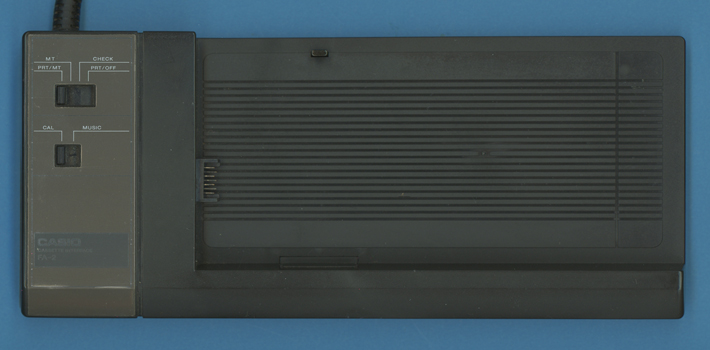
DATAMATH CALCULATOR MUSEUM
 |
DATAMATH CALCULATOR MUSEUM |
CASIO FA-2
| Date of introduction: | November 1981 | Display technology: | |
| New price: | $49.00 (MSRP 1981) | Display size: | |
| Size: | 4.0" x 8.9" x
0.95" 102 x 225 x 24 mm3 |
||
| Weight: | 7.6 ounces, 215 grams | Serial No: | 1B111A |
| Batteries: | 3*AA Alkaline | Date of manufacture: | mth 11 year 1981 |
| AC-Adapter: | Origin of manufacture: | Japan | |
| Precision: | Integrated circuits: | CPU: HD43110 | |
| Memories: | |||
| Program steps: | Courtesy of: | Joerg Woerner |

![]()
![]() Sharp
Corporation introduced in June 1980 with the PC-1210 (and its sibling
PC-1211) the World's first Pocket Computer with BASIC programmability.
It took only about three months and Matsushita defined with their
Panasonic HHC a new category of
Hand-held Computers or Portable Computers. Main competitor in Japan, Casio
Computer Co., Ltd, on the other hand introduced with the
FX-501P
and FX-502P in October 1979 their first keystroke Programmable Pocket
Calculator with LC-Display, succeeded in March 1981 with the FX-601P and
FX-602P, introducing a dot matrix LC-Display and laying the foundation for the
FX-702P "Pocket Computer". Casio took a different approach than Sharp and added
BASIC programmability to a Scientific Calculator and labeled the device with
"Programmable Calculator" accordingly. Casio's early advertisement featuring the
FX-702P used often a big headline "More Power To Your Pocket" to challenge rival Sharp.
Sharp
Corporation introduced in June 1980 with the PC-1210 (and its sibling
PC-1211) the World's first Pocket Computer with BASIC programmability.
It took only about three months and Matsushita defined with their
Panasonic HHC a new category of
Hand-held Computers or Portable Computers. Main competitor in Japan, Casio
Computer Co., Ltd, on the other hand introduced with the
FX-501P
and FX-502P in October 1979 their first keystroke Programmable Pocket
Calculator with LC-Display, succeeded in March 1981 with the FX-601P and
FX-602P, introducing a dot matrix LC-Display and laying the foundation for the
FX-702P "Pocket Computer". Casio took a different approach than Sharp and added
BASIC programmability to a Scientific Calculator and labeled the device with
"Programmable Calculator" accordingly. Casio's early advertisement featuring the
FX-702P used often a big headline "More Power To Your Pocket" to challenge rival Sharp.
The FX-702P Programmable Calculators features not only an internal expansion slot for a memory cartridge but a 7-pin connector for peripherals on its left side:
| Product | Description | MSRP (1981) |
| FA-2 | Cassette Interface (Fits FX-501P/FX-502P/FX-601P/FX-602P, too) |
$49.00 |
| FP-10 | Mini Printer, electro-sensitive FP-36 paper, up to
20 characters per line, 2 lines per second (Fits FX-601P/FX-602P, too) |
$109.00 |
| (not released) | 4k Bytes RAM module with backup battery | |
| (not released) | 8k Bytes RAM module with backup battery |
![]()
![]() Dismantling the featured Casio FA-2 Cassette Interface manufactured in
November 1981 by Casio Computers in Japan reveals an unexpected complex design
centered around a 4-bit microcontroller and powered by three AA-sizes Alkaline
batteries.
Dismantling the featured Casio FA-2 Cassette Interface manufactured in
November 1981 by Casio Computers in Japan reveals an unexpected complex design
centered around a 4-bit microcontroller and powered by three AA-sizes Alkaline
batteries.
![]()
![]() The
HD43110 microcontroller is translating the bit-stream from the FX-702P Pocket
Computer into two different tones with a frequency of around 1,2 kHz and 2.4
kHz, following the so-called Kansas City Standard:
The
HD43110 microcontroller is translating the bit-stream from the FX-702P Pocket
Computer into two different tones with a frequency of around 1,2 kHz and 2.4
kHz, following the so-called Kansas City Standard:
| • HD43110: 4-bit
microcontroller with integrated RAM and ROM manufactured by Hitachi in a CMOS process and using a 28-pin DIP (Dual In-line Package) encapsulation |
If you have additions to the above article please email: joerg@datamath.org.
© Joerg Woerner, January 5, 2021. No reprints without written permission.